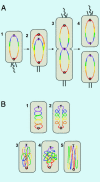Linear ordering and dynamic segregation of the bacterial chromosome
- PMID: 15199189
- PMCID: PMC438947
- DOI: 10.1073/pnas.0403722101
Linear ordering and dynamic segregation of the bacterial chromosome
Figures

Comment on
-
Rapid and sequential movement of individual chromosomal loci to specific subcellular locations during bacterial DNA replication.Proc Natl Acad Sci U S A. 2004 Jun 22;101(25):9257-62. doi: 10.1073/pnas.0402606101. Epub 2004 Jun 3. Proc Natl Acad Sci U S A. 2004. PMID: 15178755 Free PMC article.
Similar articles
-
Bacteria spring a surprise.Elife. 2014 Jun 24;3:e03435. doi: 10.7554/eLife.03435. Elife. 2014. PMID: 24963144 Free PMC article.
-
Chromosome Dynamics in Bacteria: Triggering Replication at the Opposite Location and Segregation in the Opposite Direction.mBio. 2019 Jul 30;10(4):e01002-19. doi: 10.1128/mBio.01002-19. mBio. 2019. PMID: 31363028 Free PMC article.
-
Live-Cell Fluorescence Imaging of RecN in Caulobacter crescentus Under DNA Damage.Methods Mol Biol. 2019;2004:239-250. doi: 10.1007/978-1-4939-9520-2_18. Methods Mol Biol. 2019. PMID: 31147922
-
Bacterial DNA segregation by the actin-like MreB protein.Trends Cell Biol. 2005 Jul;15(7):343-5. doi: 10.1016/j.tcb.2005.05.002. Trends Cell Biol. 2005. PMID: 15922599 Review.
-
Chromosome conformation capture assays in bacteria.Methods. 2012 Nov;58(3):212-20. doi: 10.1016/j.ymeth.2012.06.017. Epub 2012 Jul 6. Methods. 2012. PMID: 22776362 Review.
Cited by
-
SMC condensation centers in Bacillus subtilis are dynamic structures.J Bacteriol. 2013 May;195(10):2136-45. doi: 10.1128/JB.02097-12. Epub 2013 Mar 8. J Bacteriol. 2013. PMID: 23475963 Free PMC article.
-
Bacterial chromosome organization and segregation.Cold Spring Harb Perspect Biol. 2010 Feb;2(2):a000349. doi: 10.1101/cshperspect.a000349. Cold Spring Harb Perspect Biol. 2010. PMID: 20182613 Free PMC article. Review.
-
Entropy-driven spatial organization of highly confined polymers: lessons for the bacterial chromosome.Proc Natl Acad Sci U S A. 2006 Aug 15;103(33):12388-93. doi: 10.1073/pnas.0605305103. Epub 2006 Aug 2. Proc Natl Acad Sci U S A. 2006. PMID: 16885211 Free PMC article.
-
Organization of supercoil domains and their reorganization by transcription.Mol Microbiol. 2005 Sep;57(6):1511-21. doi: 10.1111/j.1365-2958.2005.04796.x. Mol Microbiol. 2005. PMID: 16135220 Free PMC article. Review.
-
Measuring chromosome dynamics on different time scales using resolvases with varying half-lives.Mol Microbiol. 2005 May;56(4):1049-61. doi: 10.1111/j.1365-2958.2005.04588.x. Mol Microbiol. 2005. PMID: 15853889 Free PMC article.
References
-
- Schrodinger, E. (1967) What Is Life? The Physical Aspect of the Living Cell & Mind and Matter (Cambridge Univ. Press, Cambridge, U.K.).
-
- Lau, I. F., Filipe, S. R., Soballe, B., Okstad, O. A., Barre, F. X. & Sherratt, D. J. (2003) Mol. Microbiol. 49, 731-743. - PubMed
-
- Webb, C. D., Teleman, A., Gordon, S., Straight, A., Belmont, A., Lin, D. C., Grossman, A. D., Wright, A. & Losick, R. (1997) Cell 88, 667-674. - PubMed
Publication types
MeSH terms
Substances
Grants and funding
LinkOut - more resources
Full Text Sources

